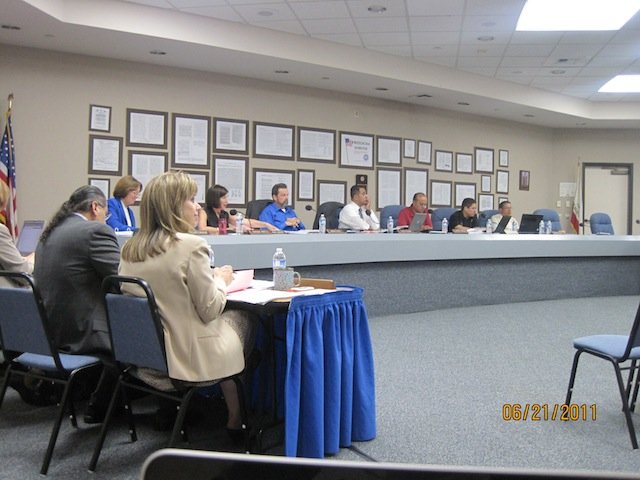It may be summer, but class is still in session for the Gilroy
Unified School Board, which gathered Thursday night for their first
public meeting in a month at 7810 Arroyo Circle. Full article
Today’s breaking news:
Two-week Rancho Hills reprieve
Council concerned east side station would wipe out downtown
Brush fire under investigation
It may be summer, but class is still in session for the Gilroy Unified School Board, which gathered Thursday night for their first public meeting in a month at 7810 Arroyo Circle.
The agenda was packed with goals, construction updates, some good news and budget blues – a lengthy to-do list that kept a small handful of attendees preoccupied until 11 p.m.
Here’s a snapshot of what’s on the plate for education leaders in the Garlic Capital.
SCHOOL BUDGET UNCERTANTIES: THE “SILLY” SAGA CONTINUES
Any dialogue involving education, the state, and money the state owes education – but has failed to cough up – is laughable to some trustees, who have come to approach the situation with a jaded arsenal of euphemisms.
“Gobbledygook.”
“The albatross around our neck.”
“The deferral hokey pokey.”
“Bobbing for apples with our hands tied behind our back.”
According to Kirsten Perez, director of Fiscal Services for GUSD, the new state budget is a dichotomous mixture of savory, and not so savory.
Bad:
–It creates more debt for schools. GUSD will have 38 percent of its funds deferred next year, which means a $8.5 to $9 million blow to its budget.
–It underfunds Proposition 98, a voter-approved measure that guarantees minimum state funding for education.
–It’s more meddling, dictating detailed terms to local school boards by telling districts what revenues they can and cannot budget for.
– During elections in November 2012, voters will get to decide whether to pass tax extensions – or “some type of revenue projection,” Perez speculates, to help fund schools. If these don’t make it through, Perez says the state plans on “repaying money it stole from us” over the next five years.
–If state revenues fall short of projections, a midyear “trigger” could cause a $260 reduction in funding per student – $2.7 million for GUSD – and a $350,000 loss in home-to-school transportation. The Catch 22, however, is that school districts are now prohibited from budgeting for this reduction thanks to AB 114, a new bill that strips counties of the responsibility for longterm fiscal oversight. The bill does not allow for any teacher layoffs or cuts to any programs in 2011-12, and state funding must remain at the 2010-11 spending level.
“How will districts plan for and handle a potential midyear budget cut if they are not allowed to budget for it?” Perez asked, posing the question during her presentation.
“Are you going to answer that?” replied GUSD Board President Rhoda Bress through skeptical laughter.
“I don’t think there’s any good answer,” said Perez.
According to AB 114, districts will have to lay out their budget on the assumption they’ll receive as much funding as they did the year before – but if state revenues plummet short of what’s anticipated, this midyear “trigger” will give GUSD Fiscal Services and the Superintendent the pleasure of budget planning on the fly.
Still, the district is technically supposed “to ignore those triggers actually they actually happen,” said Perez.
Trustee Jaime Rosso summed up the predicament, saying “it seems silly to me, that we’re expected to put it in our budget, knowing that we’re not gonna get it…silly me. Talk about trying to educate the community. It’s so difficult for ourselves, trying to have a sense of what the real numbers are.”
GUSD Superintendent Debbie Flores said the district can’t make a $2.7 million budget cut in March, and will have to formulate a plan in anticipation of the trigger going into effect.
Good:
– The state’s revised budget was passed on time.
–It provides flat funding for education. For now.
–Perez says it’s “real money,” meaning it’s fairly “certain” $80 billion of the state’s $86 billion spending plan will be available.
BRING JACK BACK
One advocate is still speaking up about her disapproval of the district’s widely criticized decision in mid-May to remove longtime athletic director Jack Daley. During public comment, GHS staff member Jan Alonso read aloud from a letter recently published in the Dispatch, underscoring the lack of evidence supporting Daley’s removal and “severe” problems in GUSD’s human resources department. With Daley gone, Alonso added she can’t think of anyone better to head up GHS’s athletic program than Julie Berggren, student activities director for the past five years.
“Julie is full of energy and school spirit and I know she will bring in many additional positive aspects to the program,” said Alonso.
Still, it’s clear she’s set on getting some answers from the district.
“We have yet to see evidence which supports (Daley’s) removal,” said Alonso. “Hiding behind confidential HR issues in this situation is wrong.”
GOALS
The district has a cornucopia of them, which they discussed publicly during the meeting as this is a part of annual protocol. Topics range from investigating the feasibility of installing solar panels at school sites, strengthening communication with parents by posting more information to GUSD’s online School Loop system, to continuously ensuring career pathways are established and in place at both high schools.
APPROVED
GUSD approved an outline for the joint use agreement with the City of Gilroy regarding the brand new aquatics center at Christopher High School. The facility’s projected utility cost is $295,727, which is to be split 50/50. GUSD has approved the agreement, which will now go before the city for approval.
VACCINE GRACE PERIOD
Trustees touched on the fact California legislation recently passed Senate Bill 614 on July 14, which grants local educational agencies an extra 30 days after classes begin to verify whooping cough vaccinations of all seventh through 12 grade students in California. GUSD is currently 70 to 80 percent on its way to collecting whooping cough immunization proof for this range of students, according to Flores.
BRIGHT SPOT
GUSD trustees were happy to receive an update from Marlene Bjornsrud, Chief Executive Officer of the Bay Area Women’s Sports Initiative. Known as BAWSI, this program was implemented in Gilroy in 2008 and currently runs at Rod Kelley, El Roble and Glen View Elementary Schools. Female coaches from Gavilan College, along with female student athletes from Gilroy and Christopher High Schools, engage young students in high-energy fitness activities, plus “locker room” discussions that encourage confidence and instill higher aspirations. Last year, BAWSI boasted a waiting list and had 1,300 girls enroll in the program, which Flores would like to see take root in every elementary school in Gilroy. “This has really surpassed our expectations,” said Bress. “It’s really difficult in these times not to be focused on those high stakes testing – but we really believe in education for the whole student, and you have enabled us to do that in the current climate.”
DOLLARS AT WORK
Trustees were given an extensive update on facilities projects funded by Measure P, the $150 million school facilities bond Gilroy voters passed in November 2008. Items in progress include modernization projects at Rucker Elementary School, a new library at Rod Kelley Elementary School, district-wide technology updates, a revamped transportation facility, updates at GHS and Phase II of CHS Construction, which includes a brand new aquatics center and a humanities building.













